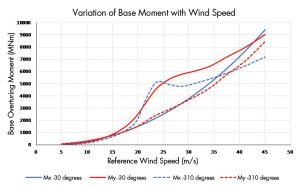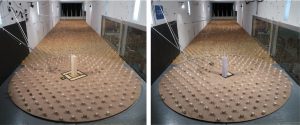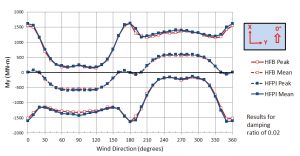What is it, and how is it implemented?
The recent publication of the ASCE/SEI Prestandard for Performance-Based Wind Design (Prestandard), and the upcoming publication of a Manual of Practice on Design and Performance of Tall Buildings for Wind prepared by an ASCE/SEI Task Committee, make this an apt time to provide an overview of the intent of these documents, the present state-of-the-art in Performance-Based Wind Design (PBWD), and current efforts to update knowledge.
The Prestandard, in its first edition, provides a roadmap to achieving the wind performance objectives specified by ASCE 7 for structural loads and building envelopes while working outside of common prescriptive procedures. The document was compiled by a working group comprised of structural engineers, building envelope engineers, wind engineers, and academics to provide a wind engineering document to complement the PEER TBI Guidelines for Performance-Based Seismic Design of Tall Buildings. The overall goals of PBWD are to allow more efficient designs that meet performance targets for building functionality while reducing property damage from wind events. The Prestandard provides a set of procedures that can be followed to show compliance with performance objectives for both strength and serviceability in design. It is laid out with the commentary interspersed among the normative text, a move that was made due to the unique nature of the content and in recognition that some areas still require further research before they can be widely applied.

Figure 1. Rainier Square, Seattle – a test case for performance-based design approaches. Courtesy of Magnusson Klemencic Associates / Michael Dickter.
The Main Wind Force Resisting System (MWFRS) portions of the Prestandard are focused on tall buildings (such as that shown in Figure 1). Tall buildings are the class of structures that have the most potential to benefit from PBWD by allowing some inelastic deformation of limited portions of the structural system under extreme wind loads. The chapter on building envelopes, though, is targeted towards all types of buildings where superior performance is required in extreme wind events, such as hospitals, data centers, and other buildings requiring post-disaster functionality. Apart from the building envelope provisions, all applications of PBWD require wind tunnel generated building-specific wind loading inputs.
The Prestandard provides clear minimum performance objectives and acceptance criteria, with associated mean recurrence intervals (MRIs), for different risk categories of buildings. The performance objectives and associated acceptance criteria are provided for Occupant Comfort, Operational and Continuous Occupancy, Limited Interruption performance objectives for the MWFRS, the building envelope, and nonstructural components and systems.
The Occupant Comfort and Operational performance objectives are evaluated using traditional linear elastic design approaches. The Operational performance assessments consider drift limits and, importantly, a Deformation Damage Index (DDI), which is a more representative technique for the assessment of racking deformation that is the primary source of damage to internal nonstructural components.
Non-Linear Time-History Analyses (NLTHA) may be utilized for the Continuous Occupancy, Limited Interruption case, to demonstrate that performance objectives are met. The Prestandard outlines three methods by which this can be achieved.
- Method 1 is a deemed-to-comply method based on engineering experience and judgment.
- Method 2 is based on NLTHA of the structure, followed by a conditional probability reliability assessment of the design. This method provides a slightly more prescriptive approach on how to use NLTHA to validate the design but also recognizes the limitations in current knowledge that may limit its practical use at present.
- Method 3 is based on NLTHA of the structure in conjunction with a dynamic shakedown analysis to evaluate the reliability of the structure. A dynamic shakedown analysis is a very computationally efficient approach that can be applied to PBWD by allowing probabilistic assessment using many time-histories.
Three types of wind tunnel tests are commonly used for the determination of overall wind loads and responses of tall buildings: High-Frequency Pressure Integration (HFPI), High-Frequency Balance (HFB) testing, and aeroelastic testing. The first two of these are what are known as aerodynamic models; they measure the external wind loads applied directly to the model with the dynamic responses calculated analytically after testing. Aeroelastic testing incorporates the structural dynamic properties into the wind tunnel model and directly measures load effects and responses.
One of the critical elements of PBWD for the structural system is optimizing the Demand-Capacity Ratios (DCRs) of individual key structural components. The techniques that can be used for this are similar to those that have been used in long-span roof analyses where pressure time-histories can be applied directly to the structural model based on areas of influence, or influence coefficients can be provided by the structural engineer to allow the wind engineer to quantify critical load effects in members. Of the three test types described above, only the HFPI approach is amenable to an easy application for PBWD. The HFB approach uses the wind tunnel model as a mechanical integrator with the applied loads measured at the base. While this is a very accurate approach in terms of the overall loads, it does not provide a direct measurement of the distribution and correlation of excitation forces over the height of the building. For many buildings designed using traditional approaches, this is of limited importance. With tall, slender buildings, the overall load effects may be dominated by resonant response, which is a function of the mass distributions and mode shapes.
For PBWD, however, it is necessary to know the distribution of the applied loads. Load distribution can only be measured directly using HFPI. This requirement leads to one of the limitations of the approach. For very tall and slender buildings, especially those with complex geometry, it is not always possible to physically fit sufficient pressure tubes into the wind tunnel model to accurately capture the simultaneous pressure distributions over the entire building. These very slender buildings are also the type where aeroelastic testing may be needed to capture aerodynamic damping effects. Therefore, composite approaches are likely to be required for particularly tall and slender buildings.
Unlike seismic loading, critical wind loads can result from uncorrelated excitation mechanisms in multiple directions. For many of the tall buildings for which the use of PBWD may be most valuable, the peak responses may result from cross-wind excitation (also referred to as vortex shedding) combined with along-wind buffeting. The rates at which the building responds to each of these phenomena with increases in wind speed are not proportional, and, in the case of cross-wind response, may exhibit peaks at less than the design wind speed. The correlations between wind speed and response can also vary widely with even small changes in wind direction. Examples of this variation are shown in Figure 2, where the base moment responses about orthogonal axes are indicated for two wind directions for a tall, slender building. The cross-wind response is particularly distinct about the x-axis for a wind direction of 310 degrees, where a vortex-shedding peak can be observed at a reference wind speed of around 24 m/s, after which the response reduces, before increasing again at higher wind speeds. Consequently, calculating the total probability of exceedance is much more computationally intensive for wind effects than for seismic effects due to the wide variation in building responses to wind.

Figure 2. Graph of along-wind and cross-wind responses for a tall, slender building for different wind directions.
Recognizing that we currently have minimal experience with the application of PBWD principles to design, a research effort is being conducted under the auspices of the ASCE 7 wind loading subcommittee. Multiple structural engineering firms developed designs for three standardized buildings located in two different wind climates representing New York and Miami. The three buildings are prismatic with two tall towers and one shorter, less dynamically sensitive building. Pressure time-histories for the buildings were measured in the wind tunnel and will be made available as open-source for reference. Figure 3 shows one of the buildings, the classical CAARC building that has long been used as a reference structure for calibrating and comparing wind tunnels, being tested using both the HFB and HFPI techniques.

Figure 3. Standardized CAARC models in the wind tunnel: High-Frequency Balance Model (left) and High-Frequency Pressure Integration model (right). Courtesy of CPP Wind Engineering.
The structural engineers did their preliminary design using codified approaches. The dynamic properties from these designs were then used in a typical linear elastic analysis using wind tunnel data to provide updated loads with which the designs were refined. This process followed the typical pattern of wind tunnel testing. A set of results for one set of structural properties is shown in Figure 4, which demonstrates good agreement between the HFB and HFPI approaches. Figure 4 also shows the dominance of the cross-wind responses, at 0° and 180°, relative to the along-wind responses, at 90° and 270°, for an isolated, prismatic tall building of relatively modest slenderness. The structural models and associated pressure time-histories were provided to Dr. Seymour Spence and his research team at the University of Michigan. They are currently subjecting the models to shakedown analysis, consistent with Method 3 of the Prestandard, to investigate the DCRs of individual members and to determine the critical governing load cases, e.g., serviceability deflections, accelerations, or member strength capacity.

Figure 4. Comparison of high-frequency balance and high-frequency pressure integration results for CAARC model.
Given the novelty of PBWD, all parties involved in the design and approval of buildings designed using PBWD approaches must be fully aware of the limitations, the risks, and the ramifications of the use of alternate methods. Consequently, independent peer review by qualified professionals is required when using this approach. In these early days, peer review is expected to be extensive and conducted by a team of reviewers with individual specialties. The local Authority Having Jurisdiction (AHJ) should also be involved from early in the decision-making process to ensure that design methodologies and reviews will be acceptable to them. To assist in this process, the Prestandard has a full chapter on peer review expectations, including scope of work and guidance on dispute resolution.
As can be concluded from the discussions above, PBWD may not yet be ready for everyday application. The Prestandard has been written with this in mind and specifically highlights current limitations. Significant progress is, however, being made to create a framework for its use and to fill in the gaps in current knowledge to facilitate the improved and more efficient design of future buildings.■
